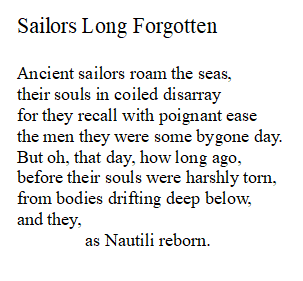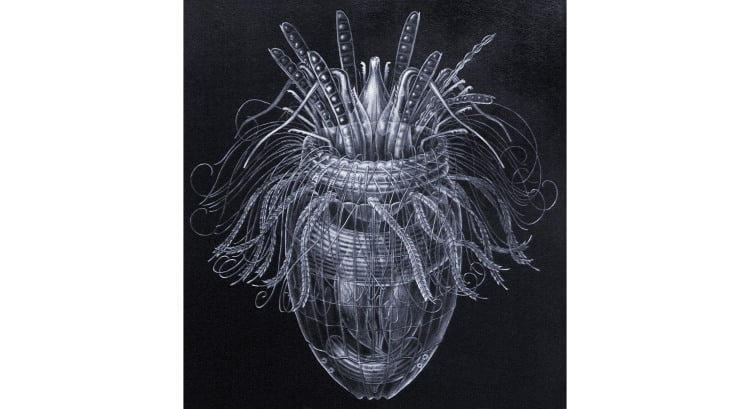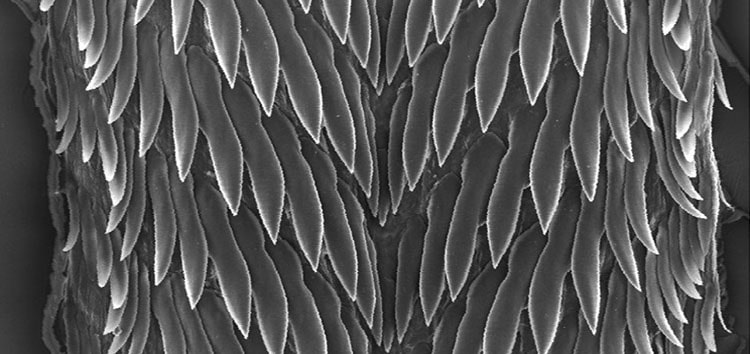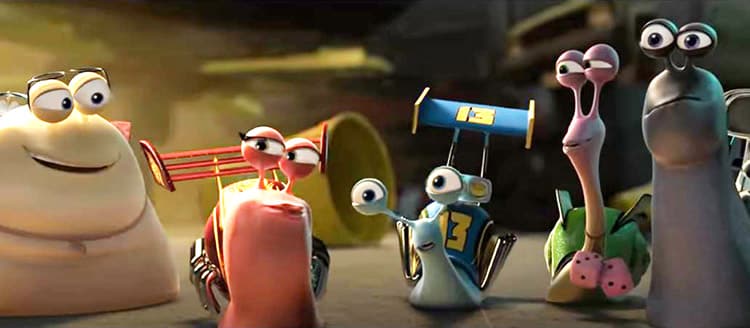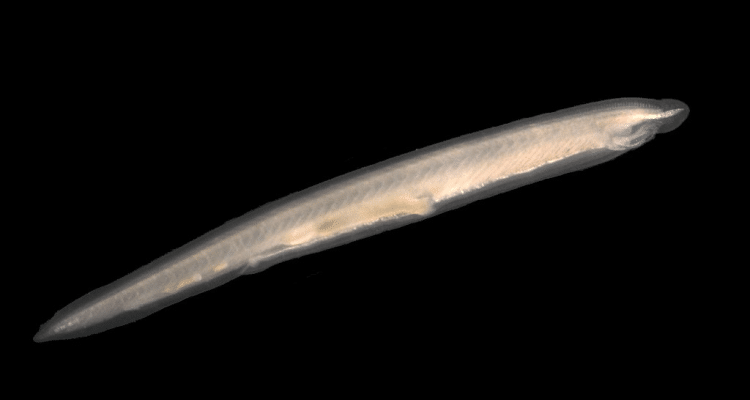Order Nautilida: The Ancient and Enigmatic Nautilus
Introduction to the Nautilus
The Nautiluses, or Nautili are a small, and very beautiful, group of living, shelled cephalopods. The word “Nautilus” shares a root with ‘nautical’ and means ‘Sailor’. It is derived from the ancient Greek ναυτίλος. Nautilus is the singular, the plural is either nautiluses or nautili. Nautiloid is another noun which can be used for the whole group, including the many extinct species.
The common names are Nautilus and Chambered Nautilus.
Nautiluses naturally occur in tropical reef habitats in the Indo-Pacific. They can be found around reefs in an area roughly bounded by Australia, Fiji, Indonesia, Myanmar, South-eastern China and the Philippines.
Nautiluses exhibit quite different life history strategies compared to other Cephalopods. They are long lived, slow growing and late maturing, taking ten to fifteen years to reach reproductive maturity. Nautiluses are slow moving, their only mode of locomotion is a gentle jet propulsion, unlike the other cephalopods all of which have several modes of locomotion (cuttlefish and squid can fin-swim as well as jet – and jet more powerfully – while octopuses can walk, crawl, glide and swim as well as jet).
Nautilluses can live for more than twenty years, but they reproduce slowly. They produce only a small number of eggs and incubate them for about a year. All this makes them vulnerable to increased predation pressures.
According to The Catalogue of Life there are 5 species of Nautilus alive today, but see the section below on taxonomy.
Threats and Conservation Status
The Nautili are famous for their attractive coiled and chambered shells. The attraction of these shells has resulted in them being collected and killed in quite large numbers. All species are currently listed as threatened while more research is being done on their population structures. Please think about the consequences before you buy a nautilus shell.
The threats to nautili do not stem just from shell collectors but arise also as a result of their being reef dwellers. Reefs are among the most threatened habits in the world, suffering as they do from various forms of pollution (as a result of being close to humanity). They are also negatively impacted by reef destruction brought about through thoughtless and greedy fishing practices and by global warming.
Nautilus Shells and the Golden Spiral
Across the web the nautilus’s shell is commonly upheld as an example of the Golden Mean, the Golden Ratio or a Fibonacci Sequence as seen in the Golden Spiral. An example of sacred mathematics occurring in Nature. But technically this is not correct.
The golden ratio is 1.618 to 1 which is designated by the Greek symbol Phi = Φ, or lowercase φ.
Firstly, the coil of a nautilus shell does not match a golden spiral. A Golden Spiral expands in dimension by the Golden Ratio with every quarter, or 90 degree, turn of the spiral. A nautilus shell comes closer to matching the ratio at every 180 degree turn, but it still doesn’t work.
Secondly there is a degree natural variation with any selected group of Nautilus shells, scientific measurement shows some to fall outside the golden spiral (they have a wider or looser spiral), and some to fall inside (they have a tighter spiral). Their ratios at 90 degrees range from about 1.24 to 1.43, with an average ratio of about 1.33 to 1. Perhaps, if you were every lucky and collected and measured hundreds you may eventually find one that matched at 180 degrees of turn. Gary B. Meisner supplies a deeper explanation of this with appropriate mathematics.
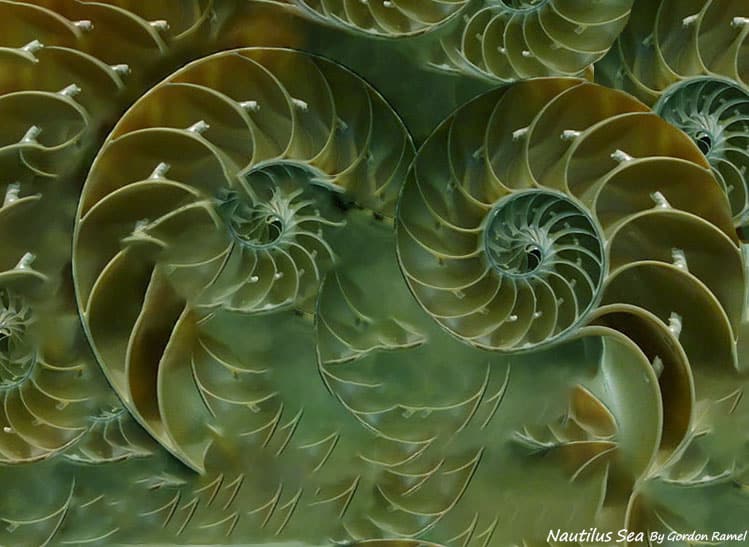
Because the distances between the turnings of the nautilus spiral increase in geometric progression (approximately) the spiral is an example of a logarithmic spiral. The golden spiral is a special kind of logarithmic spiral, one that grows outward by 1.618 every 90 degrees of turn.
Evolutionary Perspectives
Nautiluses are ancient. Their lineage stretches back in time to the to the early Cambrian; Paleozoic era (500+ million years ago). The six or so species roaming our seas today are a tiny remnant of the total number of species known; the fossil count currently stands at more than 2,500. However, even in their heyday the nautiloids were never as speciose as their cousins the ammonites. About 10,000 extinct species of ammonite have been identified.
Modern Nautiluses are not living fossils as is so often stated.
They are modern evolving species. Albeit species that have a long line of ancestors behind them. A long time ago, the nautilus line evolved a very different strategy to other cephalopods. Most cephalopods, including the ammonites as far as we know, adopted a life cycle of fast growth, bulk, semelparous (females produce only one batch of young) reproduction and short lives. Basically they chose the live in the fast lane.
Life In The Slow Lane
Nautiluses chose the other path, the slow lane. They grow more slowly, live much longer, produce fewer young at a time and are iteroparous (meaning the females can produce more than one batch of eggs).
The nautilus evolutionary line was the earliest to diverge from the ancestral cephalopod stock, splitting off from the the rest of the cephalopods before the beginning of the Silurian era around 445 MYA. Then just after the Silurian era began the Ammonite line split off. This left the ancestors of the Coleoids as the third stem. Octopuses separated out around 300 MYA in the second half of the Permian and the squid and cuttlefish only began to appear around 150 MYA in the middle of the Cretaceous.
Unlike the Ammonites in the past and the Octopus and Squid of the present there have never been that many species of Nautiloids around at any one time. However, those species that have evolved have been survivors. Nautiluses seem to have breezed through the major extinctions that decimated, and eventually eliminated, other more speciose cephalopod groups. Perhaps we should add them to the tortoise as examples of a successful opposition to the Eilkrankheit (German for “hurry sickness”) that seems to have such a drastic grip on the human race.
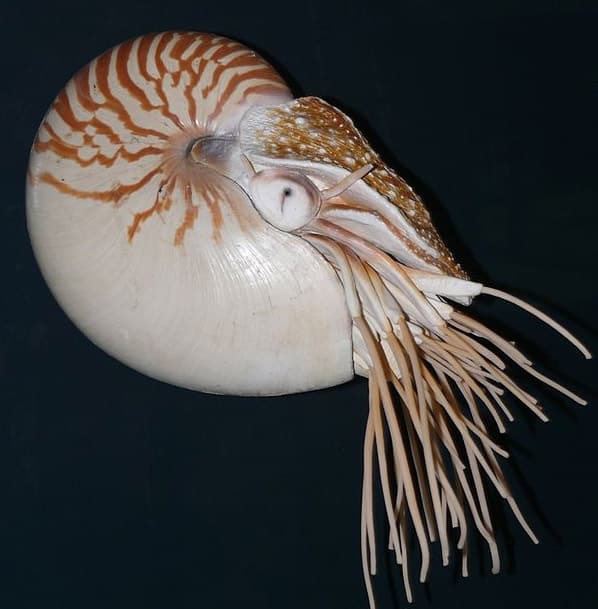
Nautilus Ecology
Nautiluses specialize in living along the deeper slopes of tropical reefs. They are mostly found at depths of between 100 and 300 meters. They are occasionally found in both deeper (to 600 meters) and shallower (to five meters in New Caledonia at night) waters. The nautilus shell is crushed by pressure at around 800 ms, killing the animal. The deepest natural record of a living nautilus is 703 meters. This was recorded at a food bait for Nautilus pompilius at the Osprey Reef Seamount, Coral Sea, Australia.
Nautiluses are highly sensitive to water temperature, preferring water temperatures of around 24 or 25 degrees C. Warmer water will kill them, which is why they are usually found at some depth. However they don’t like the water too cool either, and will migrate to shallower waters to avoid cooler temperatures.
While usually described as pelagic, because they spend their lives floating, or swimming slowly along the reef (not resting on the seafloor) they do not like truly open water. In their normal habitat they are seldom seen far from the substrate and are better described as epibenthic (living near the sea floor). This dislike of open water, and their lack of a planktonic larval stage, means populations are quite isolated. The arguments over species identities are probably caused the fact that we humans see things in a single moment of time. In a few more million years time these isolated populations may well be more easily recognized as distinct species.
Feeding and Predation
Like all cephalopods the nautili are strictly flesh eaters, either as predators or as scavengers. Although they have been little studied in the wild, their primary prey appear to be crustaceans; shrimps and crabs. Unlike other cephalopods the nautili have no suckers on their tentacles, instead the tips are covered in a sticky mucous that adheres to prey items, allowing them to be reeled in to the mouth. Nautilus are primarily nocturnal feeders and migrate vertically in the water column from their deeper day time resting areas to their shallower night-time feeding zones.
Nautiluses are primarily scavengers of dead crustaceans, though they will also feed on other phyla. Food items are detected by smell, they can easily locate dead prawns and crabs that are buried in sand and mud, or hidden in rocky crevices. Nautiluses have large olfactory (sense of smell) organs and an acute sense of smell. They are known to be able to tract dilute, and even patchy scents over large distances. They use their tentacles to extract, or dig out, the prey item before drawing it to their mouth to be eaten.
The main predators of nautili, apart from humans seeking shells for the tourist industry, are fish, sharks and octopuses. Predation by octopuses seems to be pretty major. Examination of drift shells (empty shells in the water) in the Papua region suggests 50% or more of the nautili killed by natural predators were fed on by octopuses.
Reproduction in the Nautili
Chambered nautiluses are dioecious, gonochoristic and sexually dimorphic, with mature males larger than females. Unlike the rest of the cephalopods, nautiluses are iteroparous, meaning they can mate and reproduce more than once. Other cephalopods are semelparous, the females produce only one set of eggs or young.
Nautili do not mature sexually until they are ten to twelve years old. While reproductive behaviour has not been observed in the wild, it is most likely they detect partners by scent. Laboratory studies have shown that while males are attracted to the scent of other nautiluses, both male and female, females are only attracted to the scent of males and are actually repelled by the smell of other females. Females actively avoid each other in captivity.
Nautili mate face to face and can remain “in copula” for several hours. Males pass their sperm to the females in small bags or packets called spermatophores. To do this they have an organ called a ‘spadix’ which is comprised of four modified tentacles. They deposit the spermatophore somewhere near the females mouth. Females are believed to mate with more than one male if the opportunity offers. Females lay eggs once a year.
Female cephalopods, including nautili possess paired nidamental glands. These nidamental glands are made up of secretary lamellae and are involved in the production of gelatinous substance surrounding eggs and egg masses.
Soon after mating the females lays a few relatively large eggs, ten or less. She glues these to rocky substrates in warmer surface waters. These eggs take about eleven months to hatch. When they hatch they already possess seven or eight chambers to their shell, which are about 2.5 cms in diameter. According to Barord and Basil in Chapter 10 of Cephalopod Culture; 2014 nobody has yet succeeded in breeding any species of nautilus from eggs to adults in captive conditions.
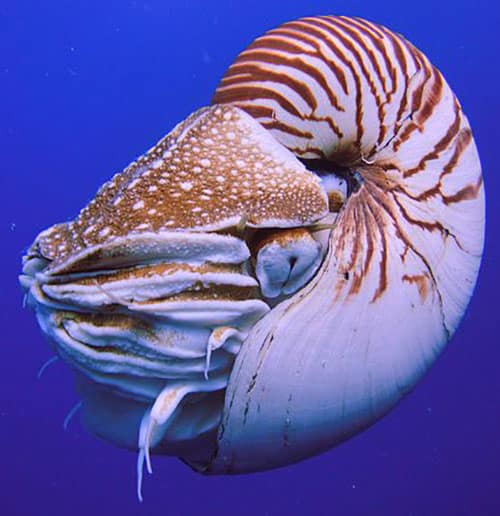
Taxonomy of Nautiloids
The species level taxonomy of the family Nautilidae is still a matter of contentious debate. The Catalogue of Life (COL) list only five species. W. B Saunders 2010 analyses recorded species names up to 2010 and concludes, that while some previous authors only accept three completely valid names, there are probably five valid names and hence five valid species. His valid species list is in harmony with the COL list, except that he ignores the work of L. Bonnaud et. al. who in 2004 raised the genus Allonautilus for the species scrobiculatus.
More recently the American National Oceanic and Atmospheric Association claims there are seven living species, but does not list their names and CITES listed six species in October 2016. Their sixth species is Allonautilus perforatus.
Finally both the U.S. Fish and Wildlife Service and Cephbase list and name seven species of extant nautiloid as of May 15 2021. Their seventh species is Nautilus repertus, however Cephbase does list this as “nom. dubium”. This is short for nomen dubium, which is Latin for “doubtful name”. Scientists append this to a name of a species in a publication when they are unsure whether or not the name represents a real species.
Phylogenetic Studies
Moving on from this a paper published in 2016 by Vandepas et. al. states quite categorically that as a result of their phylogenetic analysis using mitochondrial markers it is most likely that N. belauensis, N. stenomphalus, and N. repertus are all just morphological variations of N. pompilius.
To further complicate matters a 2017 paper by Combosch et. al., the most complete phylogenetic study to date, suggests that there are five species but that they are not the species currently recognized. Meaning their data indicates that many of the individuals currently identified as N. belauensis or N. stenomphalus etc. are not members of the same genetic group (clade). This mess will require new species to described, and currently identified species to be reassigned to the correct new taxa.
As an addendum, in May 2021 Zhang et. al. published a paper stating that the genome of N. pompilius encodes relatively fewer genes than the genome of other cephalopods. The nautilus genome apparently possesses 17,710 protein-coding genes which amounts to only 52% – 60% of the equivalent gene numbers in octopuses and squids
Phylum Mollusca
- Class Cephalopoda
- Order Nautilida
- Family Nautilidae
- Genus Nautilus
- Nautilus belauensis
- Nautilus macromphalus
- Nautilus pompilius
- Nautilus repertus (not COL or CITES)
- Nautilus stenomphalus
- Genus Allonautilus
- Allonautilus perforatus (not COL)
- Allonautilus scrobiculatus
- Genus Nautilus
- Family Nautilidae
- Order Nautilida
Humanity and the Nautilus
Ancient Perspectives
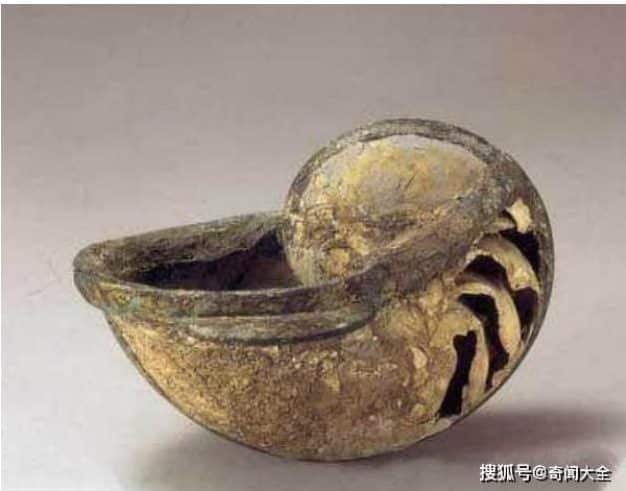
Nautiluses do not occur in Europe, so none of the ancient European cultures ever knew of their beauty. The argonaut (genus Argonauta), a type of octopus often called the ‘paper nautilus’ because the female secretes a spiral shell for itself and its eggs was well known to seafaring Mediterranean cultures. There is one line in Aristotle’s Historia Animalium, just after the section on Argonauta that states
“There is another that is found in a shell, like a snail’s; this never comes out, but remains in the shell as the snail does and sometimes puts out its tentacles.”
A number of historians have argued that this must apply to a nautilus, suggesting that Alexander The Great must have sent Aristotle shells and, or information. The truth; we may never know.
The other great ancient civilization of Eurasia, the Chinese, would have been better placed to know of the nautilus. There is some evidence that this was so, the oldest being a Nautilus cup discovered in the 1965 (Qinhuai district Nanjing) and dated to the Eastern Jin Dynasty (266 AD – 420 AD). The same paper, sent me by a Chinese friend, asserts that other cups existed in the Tang Dynasty. It is most likely that Li Bai’s reference to a “Parrot Cup” that poured more than 300 glasses of wine is in fact referring to a nautilus cup.
Strangely, in his book on ancient Cast Chinese Amulets David Hartill describes over 5,000 amulets, but none of them feature a nautilus.
The Nautilus Captures Europe
The Frenchman Pierre Belon, as far as we know, was the first European to see a nautilus shell and it was him, in a publication in 1551 who first gave the animal the name we now know it by. The first description of a nautilus with diagrams that conclusively prove that it was a Chambered Nautilus and not an Argonaut were published by Georg Everard Rumpf in 1705. However, by this time nautilus shells were already featuring in objets d’art such as the famous Delft Cup once owned by Horace Walpole and believed to have been made in 1592 in the City of Delft. Since then many cups have been created from the nautilus’s shell.
In other art a nautilus shell features in an anonymous painting, now in the Norwich Castle Museum & Art Gallery, Norfolk dating from 1665. Somewhat later, 1793 and 1797 the American inventor Robert Fulton designed a submarine, that was first tested in 1800. He called it ‘The Nautilus’. Shortly after this in the 1870s Jules Verne gave Captain Nemo a submarine named Nautilus in his stories Twenty Thousand Leagues Under the Sea (1870) and The Mysterious Island (1874). Although it apparently looked more like a stingray.
More recently still Dali produced a painting in 1941 titled “Triumph of Nautilus”. This painting does not feature any obvious nautilus images, as you might hope, but a skeletal ship with some vaguely coiled bits to it.
Modern Times
In our modern world the nautilus’s shell is a common and iconic figure. The painting by Andrew Wyeth, (July 12, 1917 – January 16, 2009), ‘Chambered Nautilus’ features a nautilus shell and is designed that the proportions of the window and the bed reflect the dimensions of the nautilus shell. The Fine Art America website lists 540 Nautilus themed paintings. However, twenty of the first 72 depicted do not contain anything vaguely nautiloid, merely other seashells, so the real number is obviously less. Pinterest image collectors represent a useful source of imagery, if not of knowledge, and many of them collect nautiloid art images, such as this, and this. Nautilus themed art is everywhere, even I have created some. Nautilus as a brand name is used to sell Marine Lifelines, Exercise Machines and Shoes.
One of the most famous cultural references to nautiluses is the poem “Chambered Nautilus” by the American poet Oliver Wendell Holmes. Aside from this the American composer Deems Taylor (December 22, 1885 – July 3, 1966) wrote a cantata entitled ‘The Chambered Nautilus’ and there was a Russian Rock Band active between 1982 and 1997 with the name Nautilus pompilius.
In other areas of our society the lure of the enigmatic nautilus remains strong. Apart from the ubiquitous Jules Verne movie remakes there was a film in 2002 about a time travelling submarine called – you guessed it – Nautilus. In 2017 the UNLOCK adventure games series released “Nautilus Traps”. More well known is League of Legends “Titan of the Depths: Nautilus“, which comes with various skins including Earthbreaker.
A search for books using the word nautilus delivers Nautilus Advanced Bodybuilding Book from 1984, A Visit from St. Nautilus, In the Chamber of the Nautilus, Nautilus: Starfarers, Book 4 and Nautilus Journal. In August 2016 P. J. Capelotti published Nautilus: a modern sequel to 20,000 Leagues Under the Sea and in October 2018 Demetri Capetanopoulos published the book The Design and Construction of the Nautilus. These and other books such as Ice Station Nautilus are tributes more to people’s obsession with Jules Verne’s writing than with any biological nautilus.
Finally there is a print and web-based quarterly Science Magazine called Nautilus. It was launched in 2013 and specializes in covering one major topic per issue.
Extinction Looms For Nautiluses
The saddest consequence of the beauty of the nautilus’s shell, and of mankind’s delight in that beauty is the current massive declines in nautilus populations, especially around The Philippines and Indonesia. When people with relative wealth are eager to pay for the right to possess this beauty it is inevitable that poor people in the 3rd world countries, where the nautili are found, will work to supply the market.
You can’t really blame the poor fishermen, their poor education is a part and parcel of their overall poverty. The only way to stop the trade is for us to stop buying the shells and kill the market for death, rather than the last few remaining nautiluses. Their slow and steady life strategy does NOT equip them to survive the onslaught of modern fishing techniques and modern human populations. So please, don’t buy that nautilus shell, buy some artwork instead. Since 2018 the Chambered Nautilus has been granted ‘Endangered Species Act’ protection. Hopefully this will still the collapse.
Further Reading For Cephalophiles
First of all, don’t forget to check out our page on nautilus anatomy.
Recent years have also seen a number of wonderful books published about cephalopods. I have read them all and can honestly say each is delightful reading, well written and full of fascinating facts and stories.
- The Soul of An Octopus: A Surprising Exploration into the Wonder of Consciousness, by Sy Montgomery (2015)
- Other Minds: The Octopus, the Sea, and the Deep Origins of Consciousness, by Peter Godfrey-Smith (2017)
- Monarchs of the Sea: The Extraordinary 500-Million-Year History of Cephalopods, by Danna Staaf (2021)
Image Credits – Cover Image by Lee R Berger; Nautilus with tentacles extended by Gunnar Ries Amphibol; Nautilus with tentacles retracted by Manuae – License CC BY-SA 3.0; Nautilus Shell Art Image – Copywrite G. Ramel 2021

